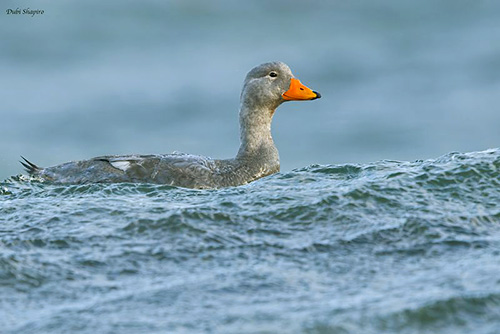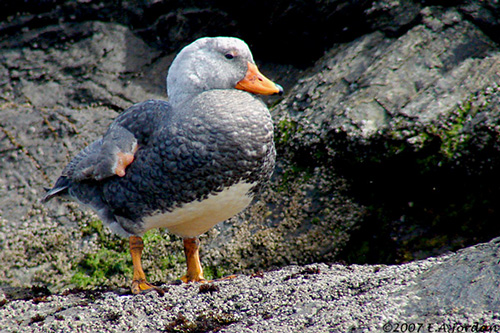
Fr: Brassemer cendré
Ang: Flightless Steamer Duck - Fuegian Steamer Duck
All: Magellan-Dampfschiffente
Esp: Quetro Austral - Quetru no volador (Chile)
Ita: Anatra vaporiera di Magellano
Nd: Reuzenbooteend
Sd: magellanångbåtsand
Photographers:
John Anderson
John Anderson Photo Galleries
Eduardo Andrés Jordan
MIS AVES – AVES DE ARGENTINA
Dubi Shapiro
Dubi Shapiro Photo Galleries
Text by Nicole Bouglouan
Sources:
HANDBOOK OF THE BIRDS OF THE WORLD vol 1 by Josep del Hoyo-Andrew Elliot-Jordi Sargatal - Lynx Edicions - ISBN: 8487334105
GUIDE DES CANARDS, DES OIES ET DES CYGNES – de Steve Madge - Delachaux et Niestlé - ISBN: 2603013769
Tachyeres pteneres (Forster, 1844)
Fuegian steamer duck, or Magellanic flightless steamer duck
Arthur Grosset's Birds (Arthur Grosset)
Wikipedia, the free encyclopaedia
Wikipedia, la enciclopedia libre
DESCRIPTION OF THE BIRD:
Biometrics:
Length: 74-84 cm
Wingspan: 85-110 cm
Weight: M: 4950-6500 g – F: 3400-5000 g
The adult male has upperparts, flanks and breast grey with pale grey/white spots. Wings and tail are shorter than in the Flying Steamer Duck. The upperwing is grey with darker grey primaries. A white speculum is formed by the white outer secondary flight-feathers. It is conspicuous when the wings are spread.
On the underparts, belly, vent and undertail-coverts are white. On the underwing, the primary and tertial flight-feathers are dark grey, whereas the secondaries are white, as the underwing-coverts. The leading edge is grey.
As in other Tachyeres species, the yellow-orange spurs at the angle of the wings are strong, but often dull, worn down and less pointed than those of the Flying Steamer Duck.
On the grey head, we can see a whitish stripe extending from the eye to the rear of the head.
The bill is orange-yellow with black nail. The eyes are dark brown. The strong legs and webbed feet are yellow with dark grey soles.

The Flightless Steamer Duck can moult up to three times a year
The female resembles male. She has orange-yellow bill too, but the head is slightly darker grey and she is smaller. The sexual dimorphism is not very marked in this species.
The juvenile is grey. The eyes are surrounded by narrow, pale eyering.
RANGE:
The Flightless Steamer Duck is found on the coast from SC Chile (Chiloé I) S to Tierra del Fuego, Argentina, including Cape Horn Archipelago.
HABITAT:
The Flightless Steamer Duck does not frequent freshwater or only for drinking, but it can be found on rocky coasts, sometimes several kilometres offshore. The species also occurs on coastal islands.
During the breeding season, it prefers the shorelines of the adjacent bays and lakes, further inland. The nest is built on the ground, protected by dense vegetation.
CALLS AND SONGS: SOUNDS BY XENO-CANTO
The sounds produced by the Flightless Steamer Duck resemble those of other Tachyeres species, but they are described as more complex, lower and more slurred. This duck gives various high-pitched whistling notes usually clear, loud and far-carrying, but these notes are rasping in the three flightless species.
The female has more grunting voice.
BEHAVIOUR IN THE WILD:
The Flightless Steamer Duck feeds primarily on molluscs, especially mussels (Mytilus), and crustaceans such as amphipods, and occasionally small fish.
It feeds by diving, dabbling and upending in shallow waters and among kelp beds, but also by wading at water’s edge.
It forages mainly around the high tide, and rests on rocks during the low tide.
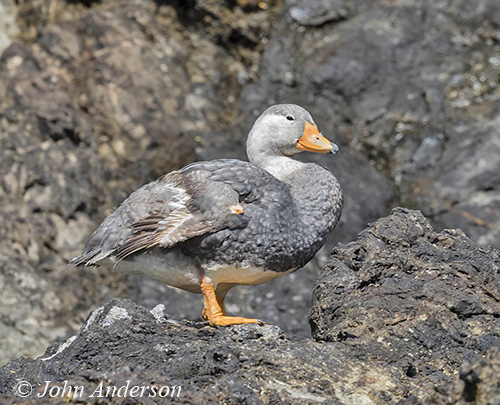
The species is monogamous with long-term pair-bonds. They are solitary nesters. The nest is on the ground, near water or not, hidden among dense vegetation.
During the mating season, the male becomes very aggressive towards other waterfowl. The territory is strongly defended during the nesting period and the male is able to kill intruders with its powerful, spurred wings.
The Flightless Steamer Duck can be seen in pairs or in family parties, and it may form small groups after the moult. During winter, it joins sometimes the Flying Steamer Duck.
The Flightless Steamer Duck is sedentary, but it may perform short dispersions along the adjacent coasts.
This species is essentially flightless because it has very short wings. It can dive both to feed and to escape. When threatened, it escapes by swimming vigorously over the water surface, helped by the flapping wings. This movement generates a wide whitish fan in the water, giving the duck its name “steamer duck”.
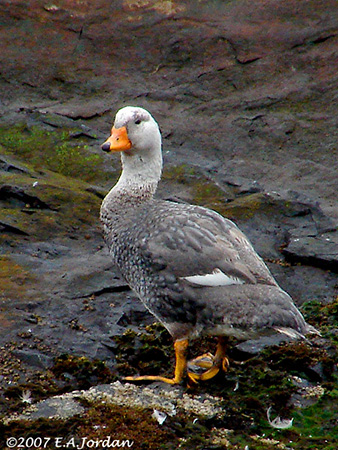
REPRODUCTION OF THIS SPECIES:
The breeding season starts in September/October, but the laying period varies, especially in the northernmost parts of the range.
The Flightless Steamer Duck nests on the ground, usually close to the high tide line. The nest is well hidden among the dense vegetation. It is described as a shallow depression lined with down and sometimes grass and twigs. The nest site is often in sheltered bays, channels, and also small islands or islets.
The female lays 4-8 eggs, and incubates alone during 30-40 days, with the male guarding the area. At hatching, the chicks have head, breast and back dark brownish-olive to smoky grey, whereas the underparts are white. The bill is black.
Both adults tend the young birds.
They fledge about 12 weeks after hatching, and they are sexually mature at 2-3 years old.
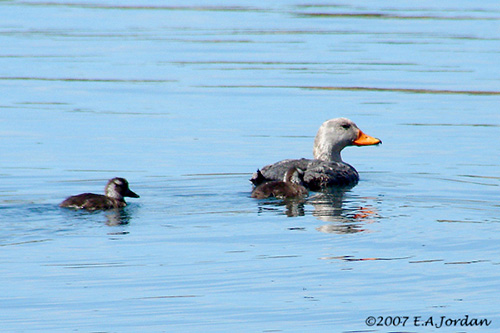
Some observations allowed to identify the main nest predators, among them, the Chimango Caracara and the Southern Crested Caracara, and also mammals such as the Fuegian Culpeo fox and the American mink
PROTECTION / THREATS / STATUS:
The Flightless Steamer Duck is threatened by frequent pollution incidents because its behaviour and ecology expose this species to the negative impact of oil spills. Habitat destruction with the restriction to the coastal areas with tidal waves, may affect the population.
The global population is placed in the band 25,000/100,000 individuals. This population is suspected to be stable. However, declines have been reported in the northernmost range in Chile.
But the Flightless Steamer Duck is not considered globally threatened at the moment, and the species is described as common to fairly abundant within its restricted range.
The Flightless Steamer Duck is currently evaluated as Least Concern.
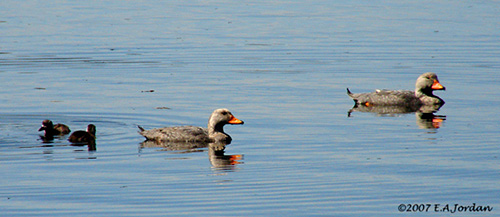
Flightless Steamer Duck or Fuegian Steamer Duck
Tachyeres pteneres
Anseriformes Order – Anatidae Family
INTRODUCTION:
The genus Tachyeres includes four almost similar species, large ducks that have partially lost the power of flight. However, they are able to fly occasionally, often low from water surface, never at great height.
They live close to coastal waters where they walk actively thanks to their powerful legs and feet.
The name of these ducks is closely related to their behaviour in the water. They perform rapid movements across the water, by using the wings in a circular padding motion to propel themselves.
The Flightless Steamer Duck is the largest species of the genus. It is native to South America, and occurs from SC Chile and Chiloé Archipelago to Tierra del Fuego, where it frequents rocky coasts and coastal islets. It feeds primarily on molluscs and crustaceans, and also some small fish. The prey are caught in shallow water.
The species is monogamous with long-term pair-bonds. The nest is on the ground and often (but not always) close to water, well protected by dense vegetation. Both parents care for the chicks.
The Flightless Steamer Duck is described as common or fairly abundant throughout the restricted range. The main threats are pollution and destruction of the habitat, but currently, the species is not globally threatened.
